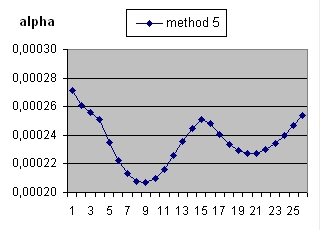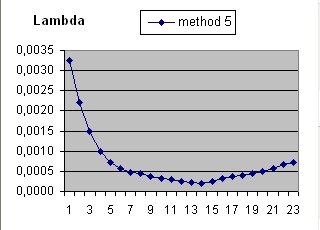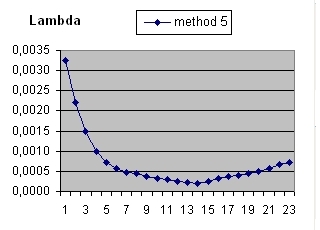 Figure 18a
Alpha versus error
Figure 18a
Alpha versus error
|
|
| Nr |
Alpha |
Lambda |
L * 10^9 |
Error |
| 1 | 0,13 | 0,0455 | 222,097 | 0,0002713 |
| 2 | 0,132 | 0,0455 | 225,782 | 0,0002605 |
| 3 | 0,134 | 0,0454 | 229,495 | 0,0002561 |
| 4 | 0,136 | 0,0565 | 176,814 | 0,0002507 |
| 5 | 0,138 | 0,0588 | 170,115 | 0,0002352 |
| 6 | 0,14 | 0,0609 | 164,444 | 0,0002223 |
| 7 | 0,142 | 0,0614 | 164,812 | 0,0002136 |
| 8 | 0,144 | 0,0632 | 160,683 | 0,0002078 |
| - | 0,145 | 0,06344 | 161,09917 | 0,00020676 |
| 9 | 0,146 | 0,0636 | 161,497 | 0,0002071 |
| 10 | 0,148 | 0,0655 | 157,138 | 0,0002099 |
| 11 | 0,15 | 0,0656 | 158,749 | 0,0002161 |
| 12 | 0,152 | 0,0673 | 155,1 | 0,000226 |
| 13 | 0,154 | 0,0682 | 153,979 | 0,0002354 |
| 14 | 0,156 | 0,0706 | 148,489 | 0,0002445 |
| 15 | 0,158 | 0,0747 | 139,057 | 0,0002511 |
| 16 | 0,16 | 0,0833 | 121,156 | 0,0002481 |
| 17 | 0,162 | 0,0864 | 116,544 | 0,0002402 |
| 18 | 0,164 | 0,089 | 113,047 | 0,0002336 |
| 19 | 0,166 | 0,0895 | 113,293 | 0,000229 |
| 20 | 0,168 | 0,0913 | 111,376 | 0,0002276 |
| 21 | 0,17 | 0,0921 | 111,212 | 0,0002272 |
| 22 | 0,172 | 0,0926 | 111,453 | 0,0002301 |
| 23 | 0,174 | 0,0944 | 109,700 | 0,0002339 |
| 24 | 0,176 | 0,0953 | 109,271 | 0,0002398 |
| 25 | 0,178 | 0,0972 | 107,315 | 0,0002466 |
| 26 | 0,18 | 0,0979 | 107,317 | 0,0002538 |
|
Table 7.6.1
|


